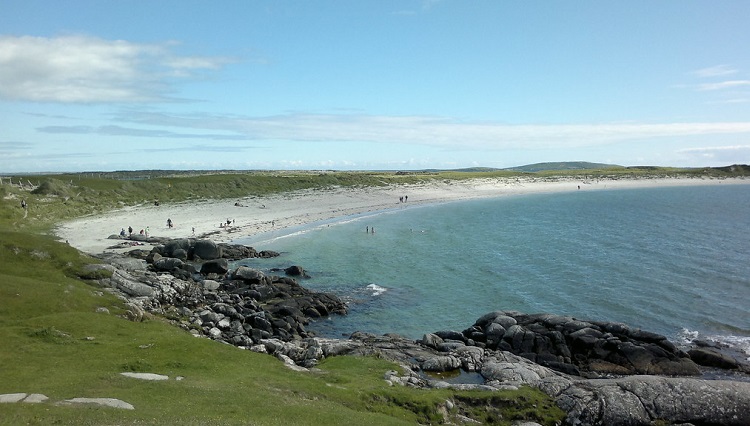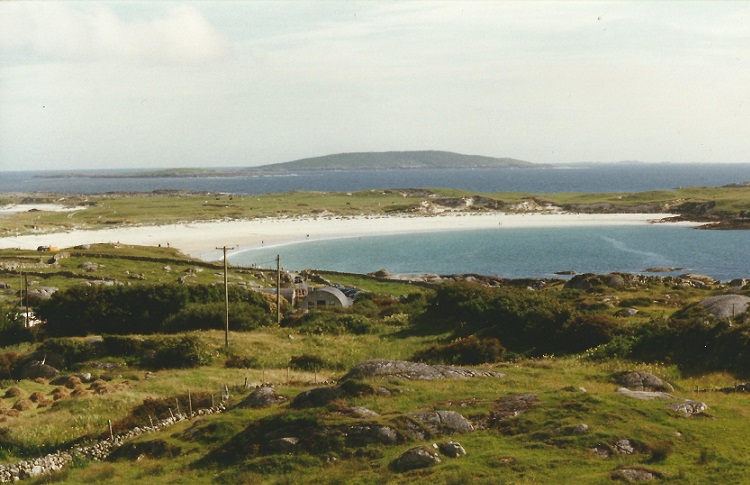Out Here | 8 | Between Micro and Macro on Dog’s Bay
Sunlight danced on the waves as they dashed themselves against the shores of Dog’s Bay. I sat on a hill looking out to sea. The Atlantic stretched away from me unbroken and smooth like black glass until it touched the sky at the horizon. There were no clouds. Just an azure sky resting on the ocean.
The depths meet the heavens out there. America lies past it, a land once known for the supposedly endless possibilities that it promised. Beyond the sky is the cosmos. Where there are more opportunities and experiences than can ever be exhausted.
Dog’s Bay is past Roundstone Village in County Galway, almost at the western extremity of Ireland. The sands of its beaches fade away into lush grass. Horses graze there without fences or boundaries or even Ireland’s famous stone walls to close them in. Dams and their foals wander among the hills and around the bay, walking its curve. I turned my head and followed the bay’s sweep from end to end. Looking out over our camp to its far side where the surfing was supposed to be good. Then I turned back to the open ocean.
Hundreds of years ago, the Atlantic was the end of the world. Out there was as alien to our ancestors as Neptune or the bottom of the ocean is to us. Out there, there was only the unknown.
Ancient man filled that void with monsters and gods and things to be afraid of. Their oceans were brimming with serpents, their skies were inhabited by thundering deities. The unknown, however, is also awesome. That sense of infinity suggests vastness and wonder too. As humanity moved into the unknown’s territory, we gained fresh insight into our world and our place. We learned what we were capable of as both builders and destroyers. New frontiers provide new knowledge and experiences and perspectives on ourselves and where we fit on this planet.
Before coming to Dog’s Bay, I had never considered the enormity of the Atlantic and the lands beyond it. Nor had I ever considered my own littleness. I had never felt as small as I did then. But I also had a sense of my place in the world, as if I understood where I was within it. That’s what adventure is; the quest to find where we fit in this existence as we venture ever outwards.
Dog’s Bay appears different to everyone who comes here. Some see barren, uncivilised land, that is void of modernity’s marvels. Others see adventure. Others still see sciences and languages to be decoded. I stood up and stretched my fingers and bare toes. I looked to the horizon one last time, the shimmering edge of sight where the sun was coming to rest. Below it lies fathoms of unknown territory. While above it lightyears of exploration await us.

I turned around and followed the beach back to camp. The fire was burning and my friends sat beside the flames drying themselves after a swim. One cracked the first beer of the night and raised it in a toast to nothing in particular.
Night closed in and the Milky Way packed the sky with constellations. I looked up from the fire and watched the smoke vanish into nothing. I found Polaris and traced the shapes of Orion and Taurus.
The highest honour Zeus could bestow on mortal beings was to raise them up into the night sky, where they would live forever as constellations. But modern man has done away with the Olympians. And humankind first raised ourselves to the stars in the mid-20th century. When the USSR and USA raced each other for “the high ground,” as outer space was called.
Soviet cosmonaut Yuri Gagarin was the first man in space. While America’s Neil Armstrong became the man on the moon. Looking down on our world from their vantage points beyond its atmosphere, seeing entire continents stretched out before them and our cities reduced to fistfuls of light, must have given Gagarin and Armstrong a sense of perspective. Just as looking out over the ocean had done for me.
I sat crosslegged on the beach by the fire and looked up at the stars. We have been studying the heavens for ages in an attempt to understand our world, its place, and ourselves. The first evidence of astronomy dates from ancient Sumer (approximately 3500-3200 BC) in Mesopotamia. This was a land that lay between the Euphrates and Tigris rivers in the Middle East. Later (ca. 1830 BC) the Babylonians were the first people to recognise the patterns of the night sky, known as the celestial sphere, and apply mathematics to the movements of the planets and stars. It is believed that the ancient Greeks learned this science from the Babylonians. Simultaneously, ancient Egyptians were studying the night sky. While some time later, during the Shang Dynasty, the Chinese were beginning to map the heavens. Drawing the shapes of the 12 constellations that make up their zodiac.
Peoples used the stars to relate the stories of their beliefs, creation, and mythologies; to place themselves within existence. The constellations were our guides through our psyches and our world. As we used them to put ourselves into perspective, we also used them to place ourselves on earth. Through a freak alignment of earth and cosmos, Polaris – the North Star – hangs above the North Pole. So long as a wanderer can see it they will never be directionless. I watched it blink in the night and felt the same sense of place I had earlier on the hilltop.
It was not a feeling of isolation or that I could not advance beyond a predetermined role. Rather, I realised that I occupied a space that was neither bigger nor smaller than myself. No different than Polaris, the Atlantic, the bay’s shoreline, or the sand-bugs.

The invention of glass is what allowed us to study the celestial sphere in detail. Without it the telescope would have been impossible. But glass, specifically glass lenses, allowed us to examine the microscopic as well as the cosmic. To see the micro-universes that fit on needle-points.
Robert Hooke and Antoni van Leeuwenhoek were the scientists who first observed microorganisms. Hooke’s 1665 book Micrographia revealed the true intricacy of the tiny. Among his drawings of flies, gnats, lice, and plant cells – all astonishing in their detail – is the first description of a microorganism; the microfungus Mucor. While van Leeuwenhoek observed and described single-celled protists in 1674.
I turned and looked towards the water. No waves could be seen in the night and it stretched from one end of the bay to the next like a big, dark prairie. Just as past explorers set out to traverse the oceans’ unknown, Hooke, van Leeuwenhoek, and those ancient peoples struck off into the unknowns of science. As they progressed, across countless miles and deeper into the mysteries encountered along the way, we attained greater insight into our significance, our size, and our powers. We sit somewhere between nuclear fusion and single-celled organisms. Every day we approach the former and distance ourselves from our beginnings in the latter, back when we were trapped in the oceans.
I raised my head and followed the curve of the celestial sphere, horizon to horizon. The sand dunes to my right were silhouetted against the sky, tracing a long, flowing brushstroke across the blackness. Blades of marram grass jackknifed up to the heavens, each one tipped by a micro-universe. As if the grass, like humankind, was reaching up to the cosmos. Up to a place above and beyond itself.
